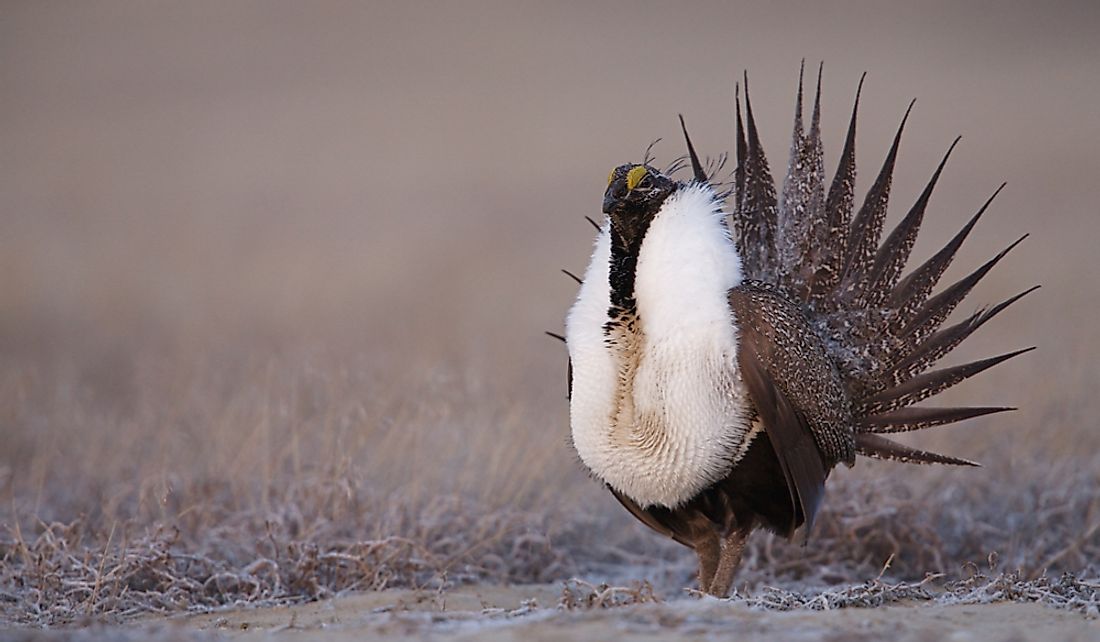Greater Sage-Grouse Facts: Animals of North America

The greater sage-grouse is the biggest North American grouse which inhabits the sagebrush steppe in the Canadian provinces of Saskatchewan and Alberta as well as 11 western US states. It was referred to as the sage-grouse until 2000 when the Gunnison sage-grouse was identified as a separate species. The population of the greater sage-grouse has been declining in its range; therefore it is listed as near threatened or threatened by numerous international and national organizations.
Description
The male greater sage-grouse weighs about 7 pounds and has a maximum length of over 30 inches while the females are 23 inches long and have a weight of about 4 pounds. The legs of the greater sage-grouse have feathers to the toes. They have long pointed tails. The adult female is gray-brown with a dark belly and light-brown throat while the males have a black belly, dark-brown throat, white breast, grayish top and yellow patches on both eyes.
Habitat and Range
These birds are permanent residents of the sage ecology, usually inhabiting the juniper sagebrush or sagebrush-grassland communities. They use the surrounding meadows as their feeding grounds. Their historical range includes Saskatchewan, British Columbia, and Alberta in Canada and sixteen American states. The Canadian population reduced by about 98% from 1988 to 2012, with the bird becoming extinct in the British Columbia while in the US it was eradicated in five American states by 2013. Today, the greater sage-grouse is found in Washington, Oregon, Idaho, Montana, Wyoming, North Dakota, South Dakota, Nebraska, Colorado, Utah, Nevada, and California.
Why Is the Greater Sage-Grouse Considered an Indicator Species?
An indicator species is an animal whose absence or presence reflects on the condition of an ecosystem, and it can be used to estimate the health of an environment. The presence of the greater sage-grouse in a sagebrush steppe is an indicator of an intact and healthy sagebrush habitat. The population of these birds in some areas has reduced as numerous human developments like gas and oil drilling expanded.
Conservation in Canada
The greater sage-grouse was listed as threatened in 1997 and then designated as endangered in 1998 in Canada. Under the Species at Risk Act, the governor in council annexed a protection order for the greater sage-grouse and this included prohibition of destruction of the sagebrush ecosystem in 2013. The law also prohibits the construction of buildings or any structure in some areas.
Conservation in the United States
The original petition to protect these birds was sent to the United States fish and wildlife service (USFWS) by Craig Dremann in June 2002. The USFWS warranted that the bird species needed to be protected under the ESA (Endangered Species Act) in 2010. The move spurred a conservation effort by numerous interested parties including environmental groups, energy producers and government agencies aimed at preventing the bird from being listed as an endangered species.
The conservation effort was successful since the interior department announced that it didn’t need to be protected under the ESA in 2015, but not everyone was happy with the news. Numerous environmental groups sued the interior department.
The government announced that it would review the Obama-era conservation plan in 2017, claiming that it will consider job creation and local economic growth. The proposed review will reduce the greater sage-grouse’s habitat by about 9 million acres for development of a bigger energy plan aimed at increasing gas and oil production. The review also gave the states the right to decide which kind of development can be allowed near the sagebrush habitat.











